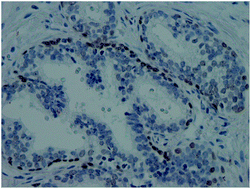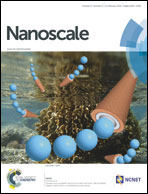Two-color SERS microscopy for protein co-localization in prostate tissue with primary antibody–protein A/G–gold nanocluster conjugates†
Abstract
SERS microscopy is a novel staining technique in immunohistochemistry, which is based on antibodies labeled with functionalized noble metal colloids called SERS labels or nanotags for optical detection. Conventional covalent bioconjugation of these SERS labels cannot prevent blocking of the antigen recognition sites of the antibody. We present a rational chemical design for SERS label–antibody conjugates which addresses this issue. Highly sensitive, silica-coated gold nanoparticle clusters as SERS labels are non-covalently conjugated to primary antibodies by using the chimeric protein A/G, which selectively recognizes the Fc part of antibodies and therefore prevents blocking of the antigen recognition sites. In proof-of-concept two-color imaging experiments for the co-localization of p63 and PSA on non-neoplastic prostate tissue FFPE specimens, we demonstrate the specificity and signal brightness of these rationally designed primary antibody–protein A/G–gold nanocluster conjugates.


 Please wait while we load your content...
Please wait while we load your content...